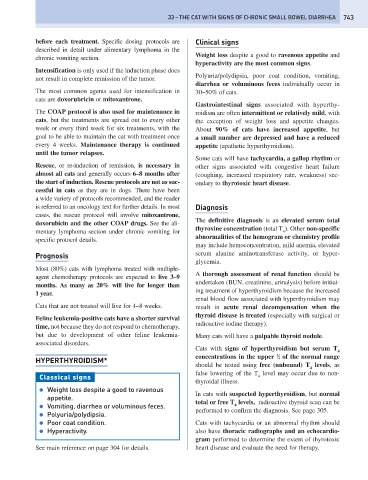Page 751 - Problem-Based Feline Medicine
P. 751
33 – THE CAT WITH SIGNS OF CHRONIC SMALL BOWEL DIARRHEA 743
before each treatment. Specific dosing protocols are Clinical signs
described in detail under alimentary lymphoma in the
Weight loss despite a good to ravenous appetite and
chronic vomiting section.
hyperactivity are the most common signs.
Intensification is only used if the induction phase does
Polyuria/polydipsia, poor coat condition, vomiting,
not result in complete remission of the tumor.
diarrhea or voluminous feces individually occur in
The most common agents used for intensification in 30–50% of cats.
cats are doxorubricin or mitoxantrone.
Gastrointestinal signs associated with hyperthy-
The COAP protocol is also used for maintenance in roidism are often intermittent or relatively mild, with
cats, but the treatments are spread out to every other the exception of weight loss and appetite changes.
week or every third week for six treatments, with the About 90% of cats have increased appetite, but
goal to be able to maintain the cat with treatment once a small number are depressed and have a reduced
every 4 weeks. Maintenance therapy is continued appetite (apathetic hyperthyroidism).
until the tumor relapses.
Some cats will have tachycardia, a gallop rhythm or
Rescue, or re-induction of remission, is necessary in other signs associated with congestive heart failure
almost all cats and generally occurs 6–8 months after (coughing, increased respiratory rate, weakness) sec-
the start of induction. Rescue protocols are not as suc- ondary to thyrotoxic heart disease.
cessful in cats as they are in dogs. There have been
a wide variety of protocols recommended, and the reader
is referred to an oncology text for further details. In most Diagnosis
cases, the rescue protocol will involve mitoxantrone,
The definitive diagnosis is an elevated serum total
doxorubicin and the other COAP drugs. See the ali-
thyroxine concentration (total T ). Other non-specific
mentary lymphoma section under chronic vomiting for 4
abnormalities of the hemogram or chemistry profile
specific protocol details.
may include hemoconcentration, mild anemia, elevated
Prognosis serum alanine aminotransferase activity, or hyper-
glycemia.
Most (80%) cats with lymphoma treated with multiple-
A thorough assessment of renal function should be
agent chemotherapy protocols are expected to live 3–9
undertaken (BUN, creatinine, urinalysis) before initiat-
months. As many as 20% will live for longer than
ing treatment of hyperthyroidism because the increased
1 year.
renal blood flow associated with hyperthyroidism may
Cats that are not treated will live for 4–8 weeks. result in acute renal decompensation when the
thyroid disease is treated (especially with surgical or
Feline leukemia-positive cats have a shorter survival
radioactive iodine therapy).
time, not because they do not respond to chemotherapy,
but due to development of other feline leukemia- Many cats will have a palpable thyroid nodule.
associated disorders.
Cats with signs of hyperthyroidism but serum T
4
concentrations in the upper ⁄2 of the normal range
1
HYPERTHYROIDISM*
should be tested using free (unbound) T levels, as
4
false lowering of the T level may occur due to non-
Classical signs 4
thyroidal illness.
● Weight loss despite a good to ravenous
In cats with suspected hyperthyroidism, but normal
appetite.
total or free T levels, radioactive thyroid scan can be
● Vomiting, diarrhea or voluminous feces. 4
performed to confirm the diagnosis. See page 305.
● Polyuria/polydipsia.
● Poor coat condition. Cats with tachycardia or an abnormal rhythm should
● Hyperactivity. also have thoracic radiographs and an echocardio-
gram performed to determine the extent of thyrotoxic
See main reference on page 304 for details. heart disease and evaluate the need for therapy.

